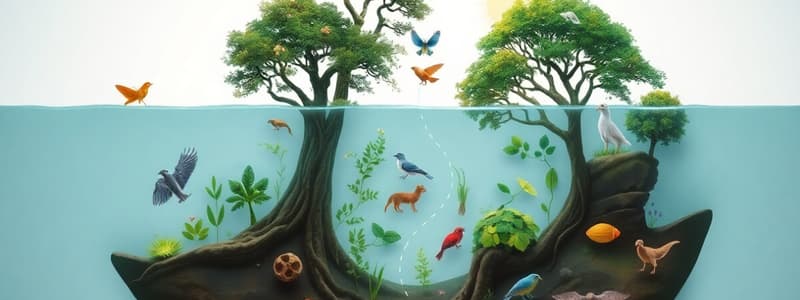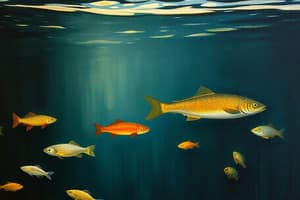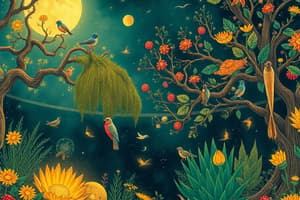Podcast
Questions and Answers
In a terrestrial ecosystem, what would be the most likely sequence of energy flow in a simplified food chain?
In a terrestrial ecosystem, what would be the most likely sequence of energy flow in a simplified food chain?
- Bird of prey → Snake → Frog → Meat-eating insects → Plant-eating insects → Grass
- Grass → Bird of prey → Snake → Frog → Meat-eating insects → Plant-eating insects
- Grass → Plant-eating insects → Meat-eating insects → Frog → Snake → Bird of prey (correct)
- Plant-eating insects → Grass → Meat-eating insects → Frog → Snake → Bird of prey
Which of the following statements best describes the role of organisms in a food chain regarding energy transfer?
Which of the following statements best describes the role of organisms in a food chain regarding energy transfer?
- Energy is destroyed as it moves from lower to higher trophic levels.
- Energy is created by consumers and then transferred to producers.
- Energy flows in both directions between organisms as they feed on each other.
- Energy is transferred from one organism to another as each organism consumes the one below it on the chain. (correct)
In a marine ecosystem, if the fish population suddenly declined due to overfishing, which of the following would most likely occur?
In a marine ecosystem, if the fish population suddenly declined due to overfishing, which of the following would most likely occur?
- An increase in the shark population due to more available food sources.
- A decrease in the dolphin population due to less available food. (correct)
- A decrease in the crustacean population, leading to an increase in algae.
- An increase in the algae population, leading to a decrease in plankton.
An organism that feeds exclusively on plant matter, such as leaves and seeds, would be classified as belonging to which trophic level in an ecosystem?
An organism that feeds exclusively on plant matter, such as leaves and seeds, would be classified as belonging to which trophic level in an ecosystem?
Consider a simplified food chain: Algae → Plankton → Crustaceans → Fish → Dolphin. If the plankton population were to suddenly decrease due to pollution, what would be the most likely short-term consequence?
Consider a simplified food chain: Algae → Plankton → Crustaceans → Fish → Dolphin. If the plankton population were to suddenly decrease due to pollution, what would be the most likely short-term consequence?
In the freshwater lake ecosystem described, what would happen to the aquatic insect population if a disease drastically reduced the aquatic plant population?
In the freshwater lake ecosystem described, what would happen to the aquatic insect population if a disease drastically reduced the aquatic plant population?
If producers in a grassland ecosystem contain 10,000 kilojoules of energy, approximately how much energy will be available to primary consumers according to the 10% rule of energy transfer?
If producers in a grassland ecosystem contain 10,000 kilojoules of energy, approximately how much energy will be available to primary consumers according to the 10% rule of energy transfer?
A food web is a more accurate representation of energy flow in an ecosystem compared to a food chain because a food web:
A food web is a more accurate representation of energy flow in an ecosystem compared to a food chain because a food web:
Carnivores, by definition, primarily consume other animals. What is the lowest trophic level that a carnivore can occupy in an ecosystem?
Carnivores, by definition, primarily consume other animals. What is the lowest trophic level that a carnivore can occupy in an ecosystem?
Producers, forming the base of the trophic pyramid, are unique because they:
Producers, forming the base of the trophic pyramid, are unique because they:
Flashcards
Ecosystem
Ecosystem
Interacting organisms and their environment in a specific area.
Food Chain
Food Chain
Representation of feeding relationships in an ecosystem.
Energy Flow
Energy Flow
Energy is transferred, not created/destroyed, through feeding.
Trophic Levels
Trophic Levels
Signup and view all the flashcards
Producers
Producers
Signup and view all the flashcards
Producers (Autotrophs)
Producers (Autotrophs)
Signup and view all the flashcards
Primary Consumers
Primary Consumers
Signup and view all the flashcards
Secondary Consumers
Secondary Consumers
Signup and view all the flashcards
Tertiary Consumers
Tertiary Consumers
Signup and view all the flashcards
Quaternary Consumers
Quaternary Consumers
Signup and view all the flashcards
Study Notes
- Ecosystems encompass all organisms in an area and their interactions, including feeding for energy.
- A food chain represents the feeding relationships within an ecosystem, showing which organisms eat or are eaten by others.
- Example food chain from a freshwater lake: aquatic plants → aquatic insects (stonefly larva) → fish (bluegill) → large predator (osprey).
Energy Flow in an Ecosystem
- Energy transfers from organism to organism through feeding, moving in a single direction within a food chain.
- In the freshwater lake example, aquatic plants use solar energy for photosynthesis.
- This energy is then transferred to stonefly larva when they consume the plants.
- The energy continues to transfer to bluegill when they eat the stonefly larva, and finally to the osprey when it eats the bluegill.
Food Chain and Trophic Levels
- Trophic levels classify an organism's position within an ecosystem and its role in energy flow.
- Energy flows from producers to consumers as organisms at higher levels consume those at lower levels.
- Aquatic plants are producers at the base of the trophic pyramid.
- Energy moves upwards: aquatic insects (primary consumers), bluegill (secondary consumers), and osprey (top-level consumer).
Producer
- Producers (autotrophs) create their own food through photosynthesis (using solar energy) or chemosynthesis (using chemical energy).
- Examples: algae, phytoplankton, aquatic duckweed, and grass.
Primary Consumer
- Primary consumers feed on producers and occupy the second trophic level.
- They are exclusively herbivores, like grasshoppers.
Secondary Consumer
- Secondary consumers feed on primary consumers and occupy the third trophic level.
- They can be carnivores or omnivores; predators start appearing at this level (e.g., robins).
Tertiary Consumer
- Tertiary consumers feed on secondary consumers, are typically predators, and can be carnivores or omnivores.
- They occupy the fourth trophic level (e.g., rat snakes).
Quaternary Consumers
- Quaternary consumers are apex predators that feed on tertiary consumers and below.
- They are typically carnivores or omnivores and are at the top of the food chain with few predators (e.g., hawks).
Herbivores, Carnivores, and Omnivores
- These terms describe the diet of organisms that eat others for energy and help determine their trophic level.
- Herbivores eat only plant matter (e.g., grasshoppers, which are primary consumers).
- Carnivores eat only meat (e.g., rat snakes, which can be secondary consumers or above).
- Omnivores eat both plants and meat and can feed at any consumer trophic level.
Food Web Energy Flow
- Food webs represent all interconnected food chains within an ecosystem.
- They illustrate how feeding relationships between organisms in different food chains interconnect.
- Energy flows upwards from producers to quaternary consumers, moving between organisms in different food chains.
- Energy transfer between trophic levels isn't perfectly efficient; roughly 10% of the energy from a lower level is transferred to the next.
- The remaining 90% of the energy is lost to heat, metabolism, or is not consumed.
- A grasshopper with 100 kJ of energy transfers only 10 kJ to a robin that eats it.
Studying That Suits You
Use AI to generate personalized quizzes and flashcards to suit your learning preferences.




